
C. S. Lewis’s Legacy: 50 Years Later, Still Growing
November 22nd, 2013 | Skip to comments
Today we celebrate the life of Clive Staples Lewis on the 50th anniversary of his death on November 22, 1963. His induction today into Westminster Abbey’s Poets’ Corner provides Professor Lewis with greater honor and attention than he could have ever imagined in his lifetime. How did he get here? How did we get here?
In October, 1946, Beloit College poet-in-residence, Chad Walsh, published a provocative profile of Clive Staples Lewis in the Atlantic Monthly, bringing to an American readership the first coherent, incisive bio-critical attention to Lewis’s life and work. In it, he documents and contextualizes the rather amazing broadcasting/ publishing exploits of the redoubtable Mr. Lewis, whom Walsh characterizes in his essay as now conducting the “thirteenth year of his one-man campaign to convert the world to Christianity.” Though his New York Times feature article followed in 1948, Walsh’s book on Lewis, Apostle to the Skeptics (1949), would emerge as the first systematic assessment of Lewis’s apologetics and what we now casually refer to as “worldview.”
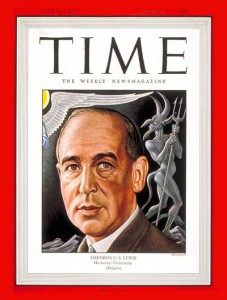 Just one year later in its September 8, 1947 issue, TIME magazine would feature Lewis in a cover story on the Oxford don; below a stylized portrait of Lewis is captioned: “Oxford’s C. S. Lewis . . . His Heresy: Christianity.” Inside, the companion essay, “Don v. Devil,” acknowledges Lewis’s success in “talking theology without pulling a long face or being dull,” noting that he possesses a “talent for putting old-fashioned truth into a modern idiom,” best exemplified, from the essayist’s point of view, in Lewis’s The Screwtape Letters.
Just one year later in its September 8, 1947 issue, TIME magazine would feature Lewis in a cover story on the Oxford don; below a stylized portrait of Lewis is captioned: “Oxford’s C. S. Lewis . . . His Heresy: Christianity.” Inside, the companion essay, “Don v. Devil,” acknowledges Lewis’s success in “talking theology without pulling a long face or being dull,” noting that he possesses a “talent for putting old-fashioned truth into a modern idiom,” best exemplified, from the essayist’s point of view, in Lewis’s The Screwtape Letters.
The common assumption at work in these early publications about Lewis is not hard to identify. It is the notion that Lewis’s personal popularity and the size of his readership, astounding as they seemed at that moment from both sides of the Atlantic, were about to crest, and he would remain noteworthy only within a predictable celebrity’s time frame, after which a fickle public would make him yesterday’s news. In fact, when Walsh returned to speculating about Lewis’s “literary legacy” again in 1979, he leveled his own dour forecast that interest in Lewis had “probably peaked.”
Neither the sympathetic Walsh nor TIME’s editors could possibly have imagined that Lewis would continue to enthrall and disciple new readers of all ages and theological persuasions for so many years. Here he is, now well into his 110th decade, still baptizing writers’ imaginations, inoculating seminarians against foolish heterodoxies, and punctuating our pulpiteers’ otherwise bland sermons with metaphorically rich quotations from his works.
“Legacies,” ahem, are for the fading fast, the recently forgotten, or the reluctantly abandoned; a stop-gap to keep them remembered among their peers. Lewis even created a category for the kind of literary genre they inspire: rehabilitations, something he’s never had to undergo, though he’s performed the service himself for as disparate a group of writers as John Milton, Jane Austen, William Morris, George MacDonald, and John Buchan. Lewis is that rara avis who both needs no introduction, and is not even close to needing any kind of dutiful literary eulogy.
Somehow Lewis manages to stay relevant era by era without even trying, and continues to be rediscovered generation by generation, community by community, and reinserted into the lives and conversations of Christians, who hear in him a winsome voice that gives them the confidence to believe.
So if we shouldn’t settle the “legacy” question just yet (it being way too early), perhaps we can deal with a more important one, in my view, paraphrased from the Psalmist: “Who is C. S. Lewis that we are mindful of him?” I believe answering this question involves less an analysis of individual Lewis works and their impact, valuable as that may be, and, instead, more attention paid to his character, to the kind of person that God—–whom Lewis gleefully referred to as “unscrupulous”—–was creating from the inside out when he commissioned this Belfast-born lad to become one of His more unlikely spokespersons.
Owen Barfield, longtime friend of Lewis, who met him first in 1919, has come the closest to explaining Lewis’s improbably abundant life in a nutshell. In his preface to a volume of essays about Lewis I was pleased to edit, Barfield remarked, “Somehow what Lewis thought about everything was secretly present in what he said about anything.” Lewis’s life was thoroughly integrated. It wasn’t compartmentalized or fragmented as he grew to become the person Walter Hooper has called “the most thoroughly converted man” he ever met, one whose whole life, whose entire repertoire of gifts and talents, dreams and visions, were fully yielded to God.
Generous to a fault with his time and money, prayerful, confessional, and evangelistic, a devoted student of Scripture and church history, this “thoroughly converted” Lewis wrote compellingly about the life and imagination of the Christian, his words having authority and presence because he had also lived it, deeply, and, as we glibly, redundantly say in the 21st Century, “authentically.” His depth and courage elicits our appreciation; no one does quite what Lewis does. One may choose to be critical, as some evangelicals have been, of his doctrine of Scripture, but it hard to imagine someone who sought harder to obey Scripture than Lewis, nor exhorted others more passionately to rely on it for authoritative guidance. His life corroborates his faith and defines his commitment.
My point is this. What continues to delay the “legacy” of Lewis and brings him new and appreciative readers everyday has only a little to do with what most of us would think of first: it is neither his skillful philosophical argumentation, which is formidable; nor the perspicacity of his reading and scholarship, which is legendary; nor the mythopoeic suggestiveness of his prose, which is masterful.
Rather, it is Who Lewis has placed at the center of his life that draws us, the One who saved him even as “the most reluctant convert in all of England.” Having equipped Lewis to deploy his polymathic learning faithfully and strategically, God set him loose to deliver eloquently “an answer” for the reason for the hope within him, empowering him to write uncommon, electric declarations like this:
If I find in myself a desire which no experience in this world can satisfy, the most probable explanation is that I was made for another world. If none of my earthly pleasures satisfy it that does not prove that the universe is a fraud. Probably earthly pleasures were never meant to satisfy it, but only to arouse it, to suggest the real thing. If that is so, I must take care, on the one hand, never to despise, or be unthankful for, these earthly blessings, and on the other, never to mistake them for the something else of which they are only a kind of copy, or echo, or mirage. I must keep alive in myself the desire for my true country, which I shall not find till after death; I must never let it get snowed under or turned aside; I must make it the main object of life to press on to that other country and to help others to do the same. (From Mere Christianity)
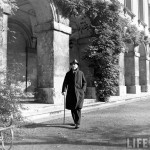 This is Lewis’s knowing, gracious appeal to our homesickness, explaining to us what is really going on in our restless hearts, pointing us home to our “true country.” This theme is pervasive in everything Lewis wrote post-conversion and forms the basis of whatever his legacy will be. Despite his prodigious talent, or, maybe because of it, Lewis can write genuinely as an “everyman,” with true empathy for our prodigal ways, the joy of our return.
This is Lewis’s knowing, gracious appeal to our homesickness, explaining to us what is really going on in our restless hearts, pointing us home to our “true country.” This theme is pervasive in everything Lewis wrote post-conversion and forms the basis of whatever his legacy will be. Despite his prodigious talent, or, maybe because of it, Lewis can write genuinely as an “everyman,” with true empathy for our prodigal ways, the joy of our return.
The “mere Christian” world Lewis promoted is “bigger on the inside than it is on the outside.” He knew what we most need, what we most want, is “the scent of a flower we have not found, the echo of a tune we have not heard, news from a country we have never yet visited,” and it is found in his sterling testimony that God has indeed provided the reality of this in Christ, not only for Lewis, but for all of us.
A version of this article originally appeared in Q as “A Writer for Restless Hearts: Discerning C.S. Lewis’ Legacy” (January, 2011).

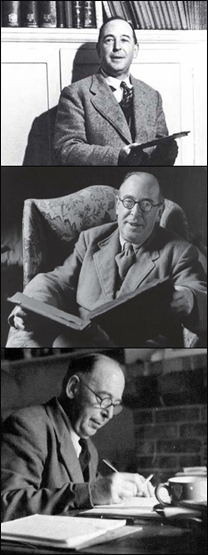
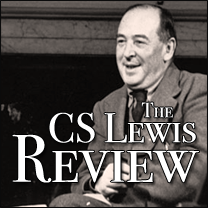
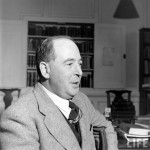
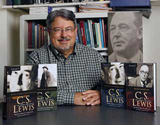
[…] This post was mentioned on Twitter by Pieter Collier, Dr. Bruce L. Edwards. Dr. Bruce L. Edwards said: CSLewis' legacy? Not so fast: http://t.co/IVxfSeh […]
Pingback by Tweets that mention Not So Fast: C. S. Lewis’s Legacy | The C. S. Lewis Review -- Topsy.com — 19 January 2011 @ 11:11 AM
[…] http://www.cslewisreview.org/2011/01/not-so-fast-c-s-lewiss-legacy/ […]
Pingback by Homesickness « Dr. Crystal Hurd — 10 June 2012 @ 8:16 PM
[…] http://www.cslewisreview.org/2013/11/not-so-fast-c-s-lewiss-legacy/ […]
Pingback by C. S. Lewis | SHOUT IT Ministries — 22 November 2013 @ 5:01 PM